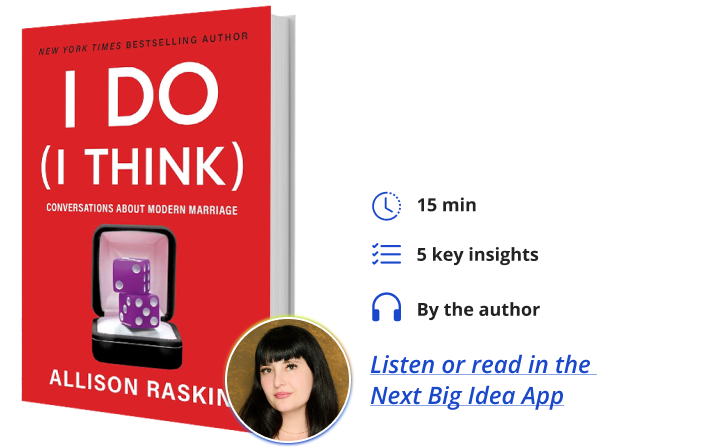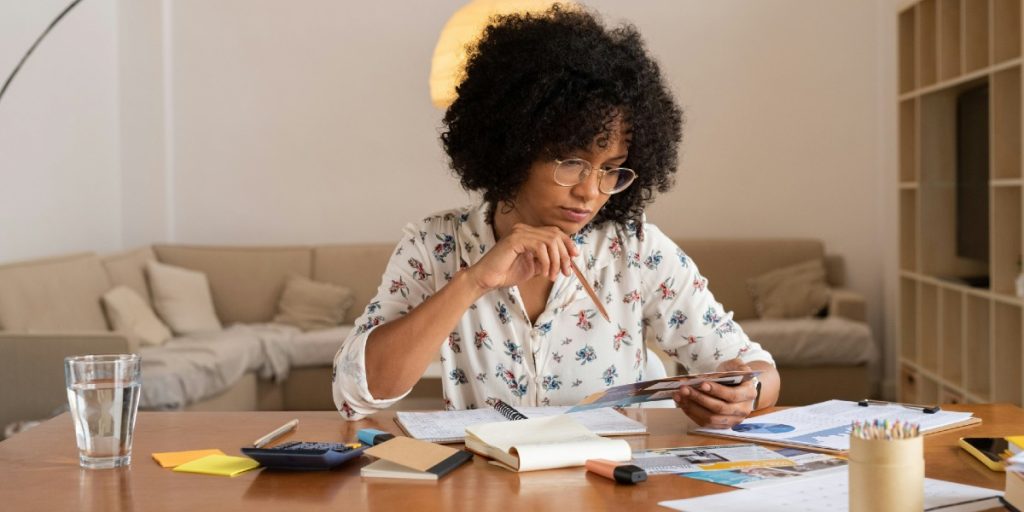Allison Raskin is a mental health advocate and New York Times bestselling author who writes both fiction and nonfiction. She co-hosts the podcast Just Between Us, a weekly comedic variety show.
What’s the big idea?
Modern marriage is full of options for customization that can create unions that are unique to a couple’s needs and personal histories. Choose to tie the knot on your terms and in your way—or forsake the institution altogether. Here is a guide to saying “I do” to your best path.
Below, Allison shares five key insights from her new book, I Do (I Think): Conversations About Modern Marriage. Listen to the audio version—read by Allison herself—in the Next Big Idea App.

1. Modern marriage is classist.
While marriage used to be one of the first steps in adulthood, now many Americans are waiting longer to get married. This shift has led to a mindset that people need to be financially stable before they are “marriage material.” The problem is that the current economy prevents many people from ever feeling like they are in a stable enough financial situation to get hitched. This means wealthier people are more likely to get married than lower-income couples, which then creates an even bigger divide because those wealthier couples get all the societal and financial benefits that come from being married.
We are trapped in a vicious cycle that can only be broken by stepping back and realizing you don’t need to build a certain level of wealth before you’re married. In fact, being married can make it easier to achieve that goal than trying to do it on your own.
2. Don’t wait for a crisis to go to couples therapy.
Couples therapy has a bad rap, but that’s just stigma talking. Couples therapy doesn’t mean your relationship is doomed. Instead, it implies that you care enough about each other to put in the work. One of the biggest mistakes couples make is waiting too long to get professional help.
“Couples therapy doesn’t mean your relationship is doomed.”
Modern couples should engage in premarital counseling whenever possible to make sure that they’ve covered all the big topics like finances, domestic labor, children, and future goals before tying the knot. The only caveat is that couples therapy isn’t covered by insurance, so it is often prohibitively expensive. But if you have the money to utilize this resource, it can save you from a lot of stress—and potentially a costly divorce.
3. We need to change the way we talk about divorce.
Framing divorce as a failure isn’t helping anyone, and it’s not accurate. Divorce exists for a reason. Having the option to end a marriage peacefully protects spouses and allows them to grow and change. A marriage doesn’t have to last until death to be additive and valuable.
Entering marriage without the harmful mindset of “We have to make it work no matter what” makes the act less terrifying in the first place. Plus, being more open to the possibility of divorce might also help people realize and embrace the usefulness of prenups and postnups, which are a great way to mitigate the risk of legally binding yourself to another person.
4. There is no right amount of time to date before getting married.
People’s personal histories and current contexts shape the way they show up in relationships. This means there isn’t a magic formula for when you know someone well enough to tie the knot. Instead of looking at the amount of time spent together, I encourage daters to look at how that time together was spent. Have you been through hardship as a couple? Do you know how your partner behaves in a crisis?
“Everyone’s path to the altar—or the courthouse—is different.”
Life and relationship experience are also factors. Older couples might not need to date for as long as younger ones because they have a better idea of what they are looking for and how to navigate a partnership. It is easy to judge other couples based on how long or short it takes them to get married, but everyone’s path to the altar—or the courthouse—is different.
5. You don’t have to get married.
The history of marriage isn’t pretty. This institution has its roots deeply tied to patriarchy, and marriage only became something other than a glorified business deal in the last seventy or so years. To this day, heterosexual marriage often has a gendering effect on couples, and men tend to get more benefits from it than women. It is entirely understandable if this isn’t something you want to opt into, especially now that people can have full lives (including cohabitation and children) without being social pariahs for not signing a marriage license first.
Now that marriage is no longer a necessity but a choice, it falls to the individual to figure out if they want to get married. What will marriage bring to your relationship that being life partners won’t? Take the time to figure it out before you say I do or I don’t. We can finally create the marriages we want instead of trying to fit ourselves into a preexisting version that doesn’t suit us.
To listen to the audio version read by author Allison Raskin, download the Next Big Idea App today:






























